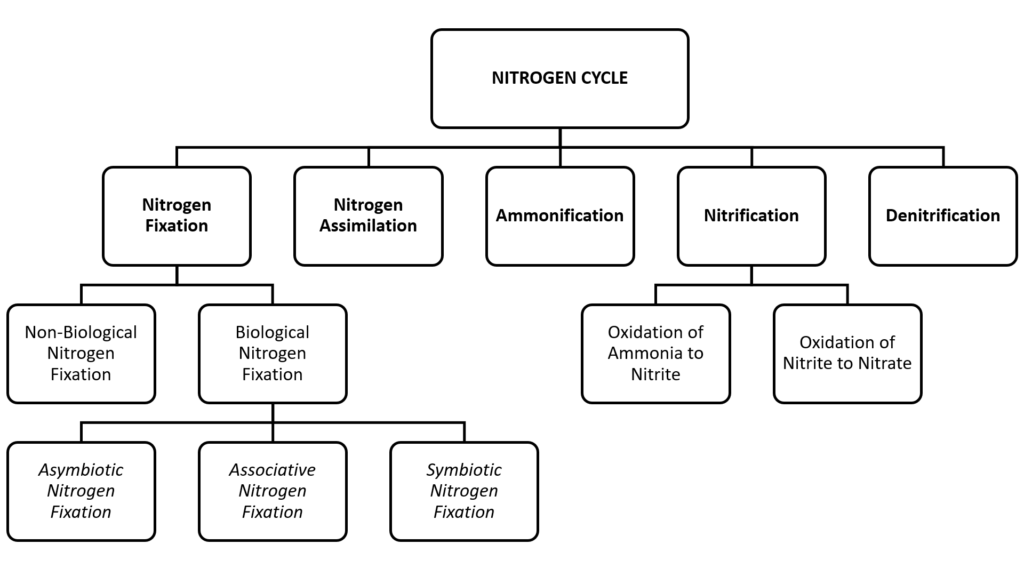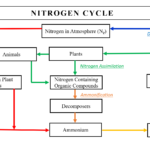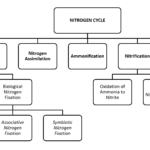The nitrogen cycle is a biogeochemical process where nitrogen is converted into various chemical forms as it circulates through the atmosphere, land, and marine ecosystems.
Despite nitrogen making up about 78% of Earth’s atmosphere, most of it is not easily accessible for biological use, causing a shortage of usable nitrogen in many ecosystems.
In the environment, nitrogen appears in several chemical forms, including organic nitrogen, ammonium (NH4+), nitrite (NO2−), nitrate (NO3−), nitrous oxide (N2O), nitric oxide (NO), and inorganic nitrogen gas (N2).
Organic nitrogen is present in living organisms, humus, or as intermediate products of organic matter decomposition. The nitrogen cycle involves the transformation of nitrogen from one form to another, a process largely driven by microbes either for energy production or nitrogen storage for growth.
5 Stages of Nitrogen Cycle
Nitrogen conversion occurs through both biological and physical processes. Key steps involve during nitrogen cycle are;
- Nitrogen Fixation
- Nitrogen Assimilation
- Ammonification
- Nitrification
- Denitrification

Nitrogen Fixation
The transformation of N2 into nitrogen that can be used biologically is known as nitrogen fixation. N2 gas is highly stable because of the strong triple bond between its nitrogen atoms, and breaking this bond demands a significant amount of energy which at least sixteen ATP molecules.
As a result, only a select group of prokaryotes are able to carry out this energetically demanding process.
Most of the nitrogen fixation during the cycle, is carried out by prokaryotes, whereas some nitrogen can also be fixed physically by lightning or by certain industrial processes.
Non-Biological Nitrogen Fixation
Nitrogen can be fixed by lightning, which converts nitrogen and oxygen in the atmosphere into nitrogen oxides. These oxides may react with water or rain to form nitrous acid or nitric acid, which then seeps into the soil, creating nitrates that plants can utilize.
Nitrogen in the atmosphere is highly stable and unreactive due to the strong triple bond between atoms in the N2 molecule. However, lightning generates enough energy and heat to break this bond, allowing nitrogen atoms to react with oxygen.
Although the initial compounds formed cannot be used by plants, as these molecules cool, they react with oxygen to form NO2. This NO2 then reacts with water to produce HNO3 (nitric acid) or its ion NO3− (nitrate), which is usable by plants.
Biological Nitrogen Fixation
Biological nitrogen fixation was first discovered by German agronomist Hermann Hellriegel and Dutch microbiologist Martinus Beijerinck. This process occurs when atmospheric nitrogen is converted into ammonia by the enzyme nitrogenase.
Biological nitrogen fixation (BNF) serves as a valuable alternative to nitrogen fertilizers. It is naturally carried out in soil by microorganisms known as diazotrophs, which include bacteria like Azotobacter and certain archaea.
All forms of biological nitrogen fixation are facilitated by nitrogenase enzymes, which contain iron and often another metal, usually molybdenum, though sometimes vanadium.
Biological nitrogen fixation can be categorized into three types:
Non- Symbiotic/ Asymbiotic Biological Nitrogen Fixation
- Soil contains various free-living nitrogen-fixing organisms, including several aerobic and anaerobic bacteria, as well as blue-green algae.
- Biological nitrogen fixation by microorganisms that live freely or outside of plant cells is known as non-symbiotic Biological Nitrogen Fixation.
- The asymbiotic nitrogen fixers can be free-living aerobic nitrogen-fixing bacteria (Chlorobium, Chromatium, Azotobacter, Azomonas), Free-living anaerobic nitrogen-fixing bacteria (Rhodospirillum), Blue-Green Algae (Nostoc, Anabaena), Free-living Fungi (Yeasts)
- These organisms are more active in fixing nitrogen under low oxygen conditions, as long as no hydrogen gas is produced.
Associative Biological Nitrogen Fixation
- Certain bacteria that live in close contact with the roots of cereals and grasses are capable of fixing nitrogen. This relationship, known as associative symbiosis, is a form of loose mutualism.
- Examples of this association include: Azospirillum brasilense with cereal roots. Beijerinckia with the roots of sugarcane. Azotobacter paspali with the roots of the tropical grass Paspalum notatum.
Symbiotic Biological Nitrogen Fixation
- Symbiotic nitrogen fixation occurs within a mutualistic relationship where plants provide a habitat and fixed carbon to bacteria in exchange for fixed nitrogen.
- This ecological association between bacteria and their host is long-term and beneficial for both parties, with the microbial partner responsible for fixing atmospheric nitrogen.
- Examples of symbiotic biological nitrogen fixation are Bradyrhizobium japonicum is a slow-growing symbiont of soybeans, Frankia, which forms root nodules in association with Alnus, Nostoc, forms association with Anthoceros, a bryophyte.

Nitrogen Assimilation
Plants take up nitrate or ammonium from the soil through their root hairs. Nitrate is initially converted to nitrite ions and then further reduced to ammonium ions, which are used to synthesize amino acids, nucleic acids, and chlorophyll.
In plants with a symbiotic relationship with rhizobia, some nitrogen is directly assimilated from the nodules as ammonium ions.
It has been discovered that there is a more complex exchange of amino acids between Rhizobia bacteroids and plants. The plant supplies amino acids to the bacteroids, eliminating the need for ammonia assimilation, and in return, the bacteroids provide amino acids containing newly fixed nitrogen back to the plant, creating a mutually dependent relationship.
While many animals, fungi, and other heterotrophic organisms obtain nitrogen by consuming amino acids, nucleotides, and other small organic molecules, some heterotrophs, including many bacteria, can use inorganic compounds like ammonium as a nitrogen source.
Ammonification
Ammonia is a form of nitrogen that can be utilized by living organisms. Organic nitrogen, present in materials like proteins, amines, amides, and urea, is converted into ammonia by microbial populations.
The extent of decomposition depends on the type of microbes acting on the organic matter. Proteins are broken down by proteolytic enzymes, which are extracellular.
Microorganisms involved in ammonification include bacteria such as Pseudomonas, Bacillus, Clostridium, and Serratia, and fungi like Alternaria, Aspergillus, Penicillium, and Mucor.
The aerobic decomposition of proteins results in carbon dioxide, ammonia, water, and sulfates, while anaerobic decomposition (putrefaction) produces hydrogen sulfide, mercaptans, and other compounds.
Ammonia production from urea involves microbes like Bacillus, Proteus, Micrococcus, and Sarcina. Amines are processed by Pseudomonas, Protoaminobacter, with the help of amino oxidases, and amides are converted to ammonia by the enzyme amidase.
Ammonia, being a volatile and positively charged compound, can disperse or bind to negatively charged clay particles in the soil. This ammonia may then be readily oxidized, leading to the next step in the cycle, which is nitrification.
Nitrification
Nitrification is the process that transforms ammonia into nitrite and then into nitrate, and it is a crucial step in the global nitrogen cycle. Most nitrification occurs aerobically and is performed solely by prokaryotes, involving two distinct phases carried out by different microorganisms.
Oxidation of Ammonia to Nitrite
- The first phase involves the oxidation of ammonia to nitrite, which is carried out by ammonia-oxidizing microbes, such as Nitrosomonas.
- These aerobic ammonia oxidizers convert ammonia to nitrite through an intermediate hydroxylamine, using two enzymes: ammonia monooxygenase and hydroxylamine oxidoreductase.
- This process produces only a small amount of energy compared to other metabolic processes, which makes these bacteria slow growers.
- Additionally, aerobic ammonia oxidizers are autotrophs, fixing carbon dioxide to produce organic carbon, similar to photosynthetic organisms, but using ammonia as their energy source instead of light. While many microbes perform nitrogen fixation, ammonia oxidation is less widespread among prokaryotes.
- It was previously believed that only a few bacterial genera, such as Nitrosomonas, Nitrosospira, and Nitrosococcus, were responsible for ammonia oxidation. However, in 2005, an archaeon capable of ammonia oxidation was discovered.
Oxidation of Nitrite to Nitrate
- The second phase of nitrification is the oxidation of nitrite (NO2−) to nitrate (NO3−), carried out by a different group of prokaryotes known as nitrite-oxidizing bacteria.
- Nitrospira, Nitrobacter, Nitrococcus, and Nitrospina involve in oxidation of nitrate. Similar to ammonia oxidizers, the energy produced from nitrite oxidation is minimal, resulting in low growth yields.
- Both ammonia- and nitrite-oxidizers must process many molecules of ammonia or nitrite to fix a single molecule of CO2. Complete nitrification requires both ammonia oxidation and nitrite oxidation.
- These microorganisms are found in various aerobic environments, including soils, estuaries, lakes, and open-ocean environments. They also play a vital role in wastewater treatment facilities by removing excess ammonium that could otherwise pollute receiving waters.
Denitrification
Denitrification is the process that converts nitrate into nitrogen gas, effectively removing bioavailable nitrogen and returning it to the atmosphere.
The final product of denitrification is dinitrogen gas (N2), though intermediate gaseous forms like nitrous oxide (N2O) also occur. Nitrous oxide is a greenhouse gas that can react with ozone and contribute to air pollution.
In contrast to nitrification, denitrification is an anaerobic process, taking place primarily in soils, sediments, and anoxic zones in lakes and oceans. Similar to nitrogen fixation, denitrification is carried out by a variety of prokaryotes, including bacteria from genera such as Bacillus, Paracoccus, and Pseudomonas.
These denitrifying bacteria are chemoorganotrophs and require organic carbon for their growth. Denitrification is crucial for removing fixed nitrogen, such as nitrate, from ecosystems and converting it into a biologically inert form (N2).
This process is especially significant in agriculture, where nitrate loss from fertilizers can be both costly and damaging. Conversely, denitrification in wastewater treatment is beneficial as it helps remove excess nitrates from wastewater, reducing the risk of adverse effects like algal blooms in the discharged water.
Importance of Nitrogen Cycle
Nitrogen cycle does have significant ecological and economic roles, which can be summarized as follows;
- Nitrogen cycle help inert nitrogen gas to get converted into usable form for plants and other organisms.
- Since, Nitrogen is crucial part of cell, as it is an component in the formation of various biomolecules.
- The photosynthetic process in plants need chlorophyll, Nitrogen is one of the major components in the formation of chlorophyll.
- This process involves in the process of ammonification, during which several decomposers converts animals and plant platter, through decomposition.
- During this cycle, nitrates and nitrites are released in soil, which will enhance the fertility of soil and increases the productivity.
- It involves in the process of denitrification, in water treatment facilities it convert the excess nitrate into nitrogen gas which is then released into the atmosphere.
FREQUENTLY ASKED QUESTIONS
What is the nitrogen cycle?

The nitrogen cycle is a biogeochemical process where nitrogen is converted into various chemical forms as it circulates through the atmosphere, land, and marine ecosystems.
List out 5 stages of nitrogen cycle.

Nitrogen conversion occurs through both biological and physical processes. Key steps involve during nitrogen cycle are;
1. Nitrogen fixation
2. Assimilation
3. Ammonification
4. Nitrification
5. Denitrification.
What is nitrogen fixation?
The transformation of free atmospheric nitrogen into nitrogen that can be used biologically is known as nitrogen fixation. Most of the nitrogen fixation during nitrogen cycle, is carried out by prokaryotes, whereas some nitrogen can also be fixed physically by lightning or by certain industrial processes.
Define nitrogen assimilation.
Nitrogen assimilation refers to the conversion of inorganic nitrogen compounds into organic forms, such as amino acids and amides. This process is essential for life on Earth, enabling the growth and development of organisms that cannot directly utilize nitrogen molecules.
What is meant by ammonification?
Ammonification is the conversion of organic nitrogen compounds into ammonia. Ammonia is a form of nitrogen that can be utilized by living organisms. Organic nitrogen, present in materials like proteins, amines, amides, and urea, is converted into ammonia by microbial populations.
What is nitrification process in nitrogen cycle?
Nitrification is the process that transforms ammonia into nitrite and then into nitrate, and it is a crucial step in the global nitrogen cycle. Most nitrification occurs aerobically and is performed solely by prokaryotes, involving two distinct phases carried out by different microorganisms.
What is denitrification process?
Denitrification is the process that converts nitrate into nitrogen gas, effectively removing bioavailable nitrogen and returning it to the atmosphere. The final product of denitrification is dinitrogen gas (N2), though intermediate gaseous forms like nitrous oxide (N2O) also occur. Nitrous oxide is a greenhouse gas that can react with ozone and contribute to air pollution.
Why is nitrogen cycle important?
Nitrogen cycle does have significant ecological and economic roles, which can be summarized as follows;
1. This process help inert nitrogen gas to get converted into usable form for plants and other organisms.
2. Since, Nitrogen is crucial part of cell, as it is an component in the formation of various biomolecules.
3. The photosynthetic process in plants need chlorophyll, Nitrogen is one of the major components in the formation of chlorophyll.
4. It involves in the process of ammonification, during which several decomposers converts animals and plant platter, through decomposition.
5. During the cycle, nitrates and nitrites are released in soil, which will enhance the fertility of soil and increases the productivity.
6. The process involves in the process of denitrification, in water treatment facilities it convert the excess nitrate into nitrogen gas which is then released into the atmosphere.


